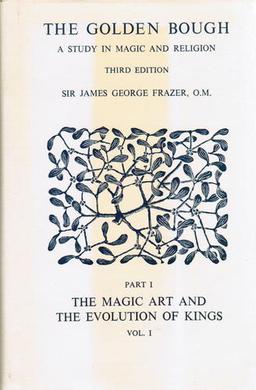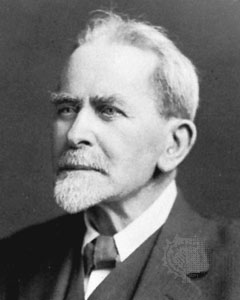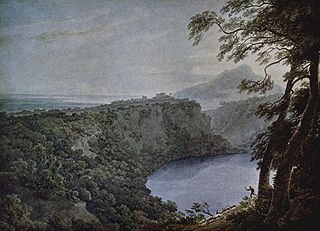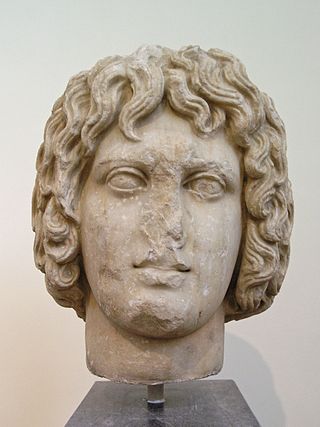Related Research Articles

Erechtheus in Greek mythology was the name of an archaic king of Athens, the founder of the polis and, in his role as god, attached to Poseidon, as "Poseidon Erechtheus". The mythic Erechtheus and the historical Erechtheus were fused into one character in Euripides' lost tragedy Erechtheus. The name Erichthonius is carried by a son of Erechtheus, but Plutarch conflated the two names in the myth of the begetting of Erechtheus.
In Greek mythology, Chrysothemis or Khrysothemis is a name ascribed to several characters.

The Golden Bough: A Study in Comparative Religion is a wide-ranging, comparative study of mythology and religion, written by the Scottish anthropologist Sir James George Frazer. The Golden Bough was first published in two volumes in 1890; in three volumes in 1900; and in twelve volumes in the third edition, published 1906–1915. It has also been published in several different one-volume abridgments. The work was aimed at a wide literate audience raised on tales as told in such publications as Thomas Bulfinch's The Age of Fable, or Stories of Gods and Heroes (1855). The influence of The Golden Bough on contemporary European literature and thought was substantial.

A dying-and-rising, death-rebirth, or resurrection deity is a religious motif in which a god or goddess dies and is resurrected. Examples of gods who die and later return to life are most often cited from the religions of the ancient Near East, and traditions influenced by them include Greco-Roman mythology. The concept of a dying-and-rising god was first proposed in comparative mythology by James Frazer's seminal The Golden Bough (1890). Frazer associated the motif with fertility rites surrounding the yearly cycle of vegetation. Frazer cited the examples of Osiris, Tammuz, Adonis and Attis, Zagreus, Dionysus, and Jesus.
In many historical societies, the position of kingship carries a sacral meaning; that is, it is identical with that of a high priest and judge. The concept of theocracy is related, although a sacred king need not necessarily rule through his religious authority; rather, the temporal position has a religious significance.

Sir James George Frazer was a Scottish social anthropologist and folklorist influential in the early stages of the modern studies of mythology and comparative religion. His reputation was improved after his new wife in 1896, Lilly Frazer, decided that he was undervalued and that she would improve his impact.

Jane Ellen Harrison was a British classical scholar and linguist. Harrison is one of the founders, with Karl Kerenyi and Walter Burkert, of modern studies in Ancient Greek religion and mythology. She applied 19th-century archaeological discoveries to the interpretation of ancient Greek religion in ways that have become standard. She has also been credited with being the first woman to obtain a post in England as a ‘career academic’. Harrison argued for women's suffrage but thought she would never want to vote herself. Ellen Wordsworth Crofts, later second wife of Sir Francis Darwin, was Jane Harrison's best friend from her student days at Newnham, and during the period from 1898 to her death in 1928.
The Triple Goddess is a deity or deity archetype revered in many Neopagan religious and spiritual traditions. In common Neopagan usage, the Triple Goddess is viewed as a triunity of three distinct aspects or figures united in one being. These three figures are often described as the Maiden, the Mother, and the Crone, each of which symbolizes both a separate stage in the female life cycle and a phase of the Moon, and often rules one of the realms of heavens, earth, and underworld. In various forms of Wicca, her masculine consort is the Horned God.

George Gilbert Aimé Murray was an Australian-born British classical scholar and public intellectual, with connections in many spheres. He was an outstanding scholar of the language and culture of Ancient Greece, perhaps the leading authority in the first half of the twentieth century. He is the basis for the character of Adolphus Cusins in his friend George Bernard Shaw's play Major Barbara, and also appears as the chorus figure in Tony Harrison's play Fram.

The rex Nemorensis was a priest of the goddess Diana at Aricia in Italy, by the shores of Lake Nemi, where she was known as Diana Nemorensis. The priesthood played a major role in the mythography of James George Frazer in The Golden Bough; his interpretation has exerted a lasting influence.
A pharmakós in Ancient Greek religion was the ritualistic sacrifice or exile of a human scapegoat or victim.
Archetypal literary criticism is a type of analytical theory that interprets a text by focusing on recurring myths and archetypes in the narrative, symbols, images, and character types in literary works. As an acknowledged form of literary criticism, it dates back to 1934 when Classical scholar Maud Bodkin published Archetypal Patterns in Poetry.

Diana Nemorensis, also known as "Diana of the Wood", was an Italic form of the goddess who became Hellenised during the fourth century BC and conflated with Artemis. Her sanctuary was to be found on the northern shore of Lake Nemi beneath the cliffs of the modern city Nemi. This lake is referred to by poets as speculum Dianae – "Diana's Mirror"; by the town of Aricia which was situated about three miles off, at the foot of the Albanus Mons, the Alban Mount, and separated by a steep descent from the lake, which lies in a small crater-like hollow on the mountainside.

Myth and ritual are two central components of religious practice. Although myth and ritual are commonly united as parts of religion, the exact relationship between them has been a matter of controversy among scholars. One of the approaches to this problem is "the myth and ritual, or myth-ritualist, theory," held notably by the so-called Cambridge Ritualists, which holds that "myth does not stand by itself but is tied to ritual." This theory is still disputed; many scholars now believe that myth and ritual share common paradigms, but not that one developed from the other.
The Holly King and Oak King are personifications of the winter and summer in various neopagan traditions. The two kings engage in endless "battle" reflecting the seasonal cycles of the year: not only solar light and dark, but also crop renewal and growth. During warm days of Midsummer the Oak King is at the height of his strength; the Holly King regains power at the Autumn equinox, then his strength peaks during Midwinter, at which point the Oak King is reborn, regaining power at the Spring equinox, and perpetuating the succession.
In Greek and Roman mythology, Glaucus, usually surnamed as Potnieus, was a son of Sisyphus whose main myth involved his violent death as the result of his horsemanship. He was the king of the Boeotian city of Potniae or sometimes of Corinth. Glaucus was the subject of a lost tragedy by Aeschylus, Glaucus Potnieus(Glaucus at Potniae), fragments of which are contained in an Oxyrhynchus Papyrus.

Robert Fraser FRSL is a British author and biographer.

In ancient Greek religion and myth, Eubuleus is a god known primarily from devotional inscriptions for mystery religions. The name appears several times in the corpus of the so-called Orphic gold tablets spelled variously, with forms including Euboulos, Eubouleos and Eubolos. It may be an epithet of the central Orphic god, Dionysus or Zagreus, or of Zeus in an unusual association with the Eleusinian Mysteries. Scholars of the late 20th and early 21st centuries have begun to consider Eubuleus independently as "a major god" of the mysteries, based on his prominence in the inscriptional evidence. His depiction in art as a torchbearer suggests that his role was to lead the way back from the Underworld.

The Golden Bough is a painting from 1834 by the English painter J. M. W. Turner. It depicts the episode of the golden bough from the Aeneid by Virgil. It is in the collection of the Tate galleries.

Lilly Frazer previously Lilly Grove became Lilly, Lady Frazer born Elisabeth Johanna de Boys Adelsdorfer was a French born British writer and translator.
References
- ↑ R Fraser ed., The Golden Bough (Oxford 2009) p. 651
- ↑ "Folklore Forum" (PDF). scholarworks.iu.edu.
- ↑ Quoted in R Fraser ed., The Golden Bough (Oxford 2009) p. 651
- ↑ R Fraser ed., The Golden Bough (Oxford 2009) p. 651
- ↑ R Fagles trans., The Oresteia (Penguin 1981) p. 18
- ↑ N Frye, Anatomy of Criticism (Princeton 1971) p. 108-9 and p. 171
- ↑ Calder, William M. (5 February 2001). "Review of Robert Ackerman, The Myth and Ritual School: J. G. Frazer and the Cambridge Ritualists". Bryn Mawr Classical Review. Archived from the original on 6 August 2019. Retrieved 24 September 2019.